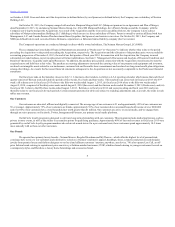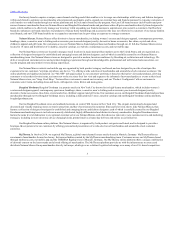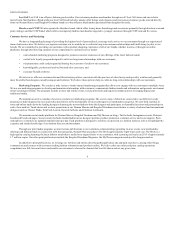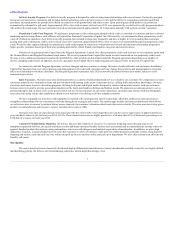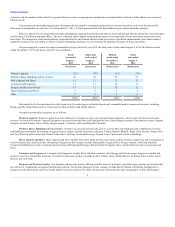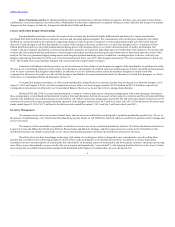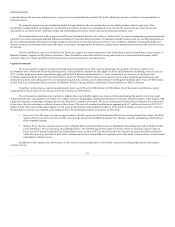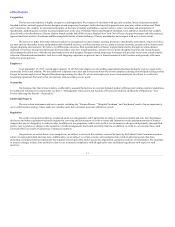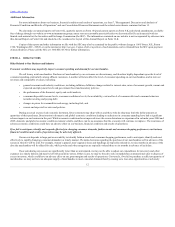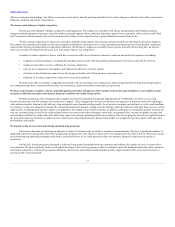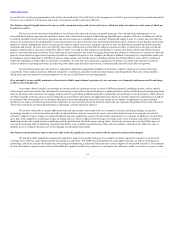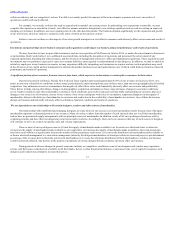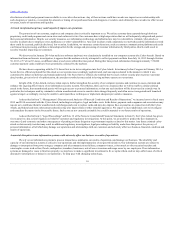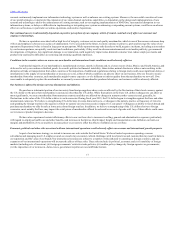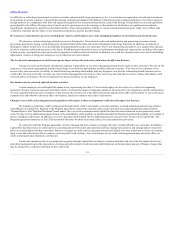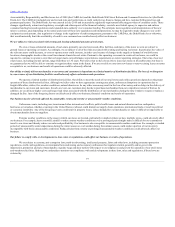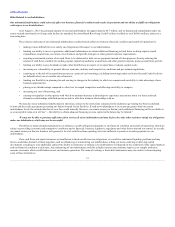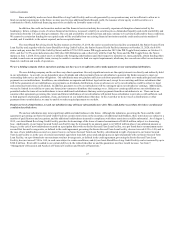Neiman Marcus 2014 Annual Report Download - page 15
Download and view the complete annual report
Please find page 15 of the 2014 Neiman Marcus annual report below. You can navigate through the pages in the report by either clicking on the pages listed below, or by using the keyword search tool below to find specific information within the annual report.
Table of Contents
by our InCircle loyalty program members who achieved reward status. If our InCircle loyalty program were to fail to provide competitive rewards and quality
service to our customers, our business and results of operations could be adversely affected.
Our business depends significantly on the success of the expansion and growth of our retail stores, which are subject to numerous risks, some of which are
beyond our control.
The success of our business is dependent on our ability to develop and execute our growth strategies. Our continued growth depends on our
successful development, opening and operation of new stores. Successful execution of this strategy depends upon a number of factors, including our ability
to identify suitable sites for new stores, negotiate and execute leases on acceptable terms, construct, furnish and supply a store in a timely and cost effective
manner, accurately assess the demographic or retail environment at a given location, hire and train qualified personnel, obtain necessary permits and zoning
approvals, obtain commitments from a core group of vendors to supply a new store, integrate a new store into our distribution network and build customer
awareness and loyalty. Our new stores are typically large‑scale construction projects that are subject to numerous risks. Construction costs may exceed our
original estimates due to increases in materials, labor or other costs, and we may experience permitting or construction delays, which may further increase
project costs and delay projected sales. These risks may be exacerbated to the extent we engage third party developers or contractors in connection with such
projects or are subject to approvals of regulatory bodies to complete the projects. For example, the Shops at Hudson Yards project is a significant, multi‑year
development project managed by a third party and we cannot assure you that the project, including the full‑line Neiman Marcus store, will be completed
within the timeframe or budget that we currently contemplate. As each new store represents a significant investment of capital, time and other resources,
delays or failures in opening new stores, or achieving lower than expected sales in new stores, could materially and adversely affect our growth.
Our growth strategies may also lead us to expand into additional geographical markets in the future, either by opening new stores or through
acquisitions. These markets may have different competitive conditions, consumer trends and discretionary spending patterns than our existing markets,
which may cause our operations in these markets to be less successful than in our existing markets.
If we are unable to successfully maintain a relevant and reliable omni‑channel experience for our customers, our financial performance and brand image
could be adversely affected.
As an omni‑channel retailer, increasingly we interact with our customers across a variety of different channels, including in‑store, online, mobile
technologies, and social media. Our customers are increasingly using tablets and mobile phones to make purchases online and facilitate purchasing decisions
when in our stores. Our customers also engage with us online by providing feedback and public commentary about all aspects of our business. Omni‑channel
retailing is rapidly evolving, and our success depends on our ability to anticipate and implement innovations in customer experience and logistics to appeal
to customers who increasingly rely on multiple channels to meet their shopping needs. If for any reason we are unable to implement our omni‑channel
initiatives, provide a convenient and consistent experience for our customers across all channels or provide our customers the products they want, when and
where they want them, our financial performance and brands could be adversely affected.
We are also vulnerable to certain additional risks and uncertainties associated with our e‑commerce websites, including changes in required
technology interfaces, website downtime and other technical failures, internet connectivity issues, costs and technical issues as we upgrade our website
software, computer viruses, changes in applicable federal and state regulations, security breaches and consumer privacy concerns. In addition, we must keep
up to date with competitive technology trends, including the use of new or improved technology, evolving creative user interfaces and other e‑commerce
marketing trends such as paid search, re‑marketing and the proliferation of mobile usage, among others, which may increase our costs and which may not
succeed in increasing sales or attracting customers. Our failure to successfully respond to these risks and uncertainties could adversely affect the sales or
margins in our e‑commerce business, as well as damage our reputation and brands.
Our business and performance may be adversely affected by the significant costs associated with our expansion and growth strategies.
We intend to make significant ongoing investments to support our growth strategies. For example, we make capital investments in our new and
existing stores, websites, omni‑channel model (including in connection with NMG One) and distribution and support facilities, as well as in information
technology, and incur expenses for headcount, advertising and marketing, professional fees and other costs in support of our growth initiatives. The amounts
of such investments, expenses and costs are often difficult to predict because they require us to anticipate our customers’ needs, our needs as we grow, trends
14


